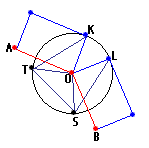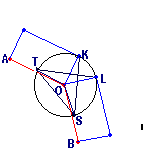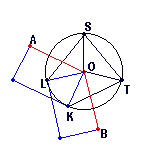Height
of an Edge Expanded Bi-prism
Consider the generic{n/d} endo (k,w) EEB.
In Fig
1 below: A, O and B are successive vertices of the base polygon. K and
L are equatorial vertices of the square faces. S and T are equatorial vertices
of the triangular faces �

[Fig 1: Vertex diagram for endo (k,w)=(3,0)]
Angle
AOB
is the internal angle of the base polygon and is given by
Angles
AOK
and BOL are internal angles of the square faces, so:
The angle
KOL
is filled (i) by the base polygon plus two right angles (from the square
faces) and (ii) by the angles subtended by k triangular faces meeting
at O.
Let angle 
Then angles:
i.e.

[Fig 2: Vertex diagram for endo (k,w)=(3,1)]
If the triangular faces are
�wound�, then we need to add 2.pi.w to the left side of the above
equation, where w is the �winding number�.
In Fig 2 above the triangular
faces run counter-clockwise from K to S, then S to T and T to L.
The angle completed is from OK to OL plus 2.pi.
So: 

As triangles
OKS,
OST
and OTL all have base lines in the equatorial plane then
KS =
ST = TL = 1
Let distance
OS
= s.Then
OS =
OT = OL = s
Considering
(for example) the triangle KOS, we obtain
The height
(h) of the EEB is given by
So substituting
for s:


[Fig 3: Vertex diagram for exo (k,w)=(3,0)]
For exo-EEB�s, equation (A) above becomes
which
simplifies again to
and so;

showing
that the heights of the endo (k,w) and exo (k,w) EEB�s are
the same.